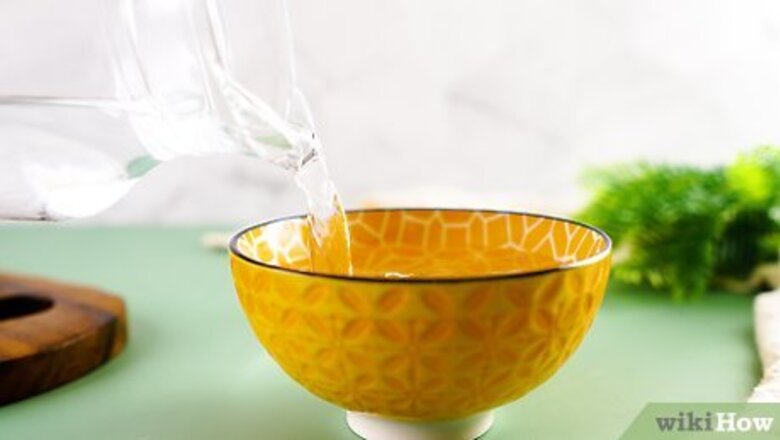
views
Making a Salt Bath
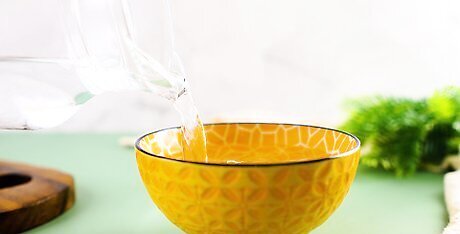
Pour two cups of hot water into a bowl. You just need enough to cover the jewelry you're cleaning. This method works as a gentle cleanser that removes tarnish without abrading the silver. If your silver is lightly tarnished, the salt bath should take the tarnish right off. If you're cleaning a lot of jewelry at once, you can use more water. For just one piece of jewelry, use less water. If your jewelry has gemstones, make sure they won't be affected by being submerged in a saltwater solution. This solution is gentle on most stones, but if you're cleaning very fine jewelry with expensive gemstones, you're better off taking it to a professional just in case. You can also contact your jeweler for advice.
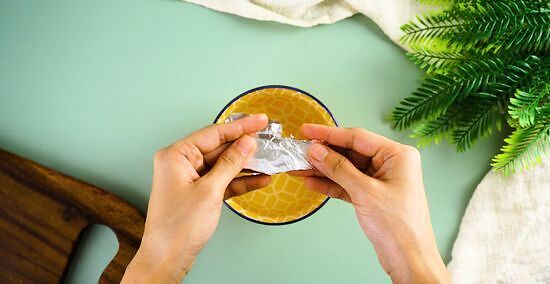
Add salt and aluminum foil. Stir one tablespoon of salt it into the hot water with a spoon until it completely dissolves. Take a sheet of aluminum foil and tear off a few strips, then put them in the bowl. The combination of salt and aluminum will react with the tarnish on the silver's surface and create a bright, shiny surface in place of the tarnish. Tarnish happens when the surface of silver combines with sulfur and turns into silver sulfide, which is black. When silver sulfide reacts with aluminum in a salt solution, the chemical reaction between the substances turns the silver sulfide back to silver. The reaction happens faster when the solution is warm. If you don't have table salt on hand, you can use baking soda instead. It has the right properties to facilitate the same chemical reaction.
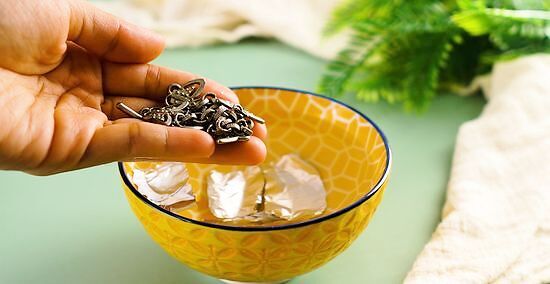
Submerge your jewelry in the solution. Allow it to sit for 5 minutes. Stir it around a bit to see whether the tarnish is going away. When you see that the silver's shine has been restored, remove the silver from the solution. If you're working with deeply tarnished silver, you might need to repeat the process two or more times. Make sure the solution is completely heated, since the reaction is much slower if the solution is cool.
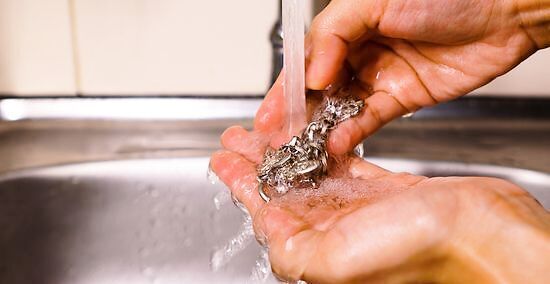
Rinse the jewelry. Run it under cool running water to rinse off the salt, then gently dry it using a soft cloth or microfiber towel. The jewelry should be good as new. If you still see signs of tarnish, repeat the process until it looks clean.
Deep Cleaning Silver Jewelry
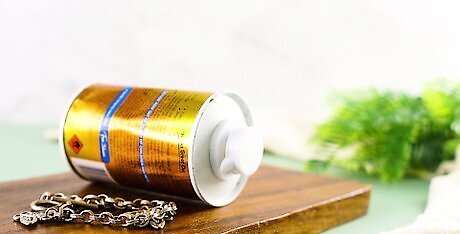
Purchase a silver polish. When tarnish develops on silver, a simple salt and aluminum bath may not suffice to remove it. Specially formulated silver jewelry polishes are your safest option for polishing silver jewelry, especially if you are dealing with an antique or a piece that has intricate designs etched into it. Even special polishes can remove a layer of silver, so get a professional cleaning if you're dealing with a delicate piece. Instead of buying silver polish from the drugstore, consider getting it from a jewelry store or a store with a high-quality jewelry department.
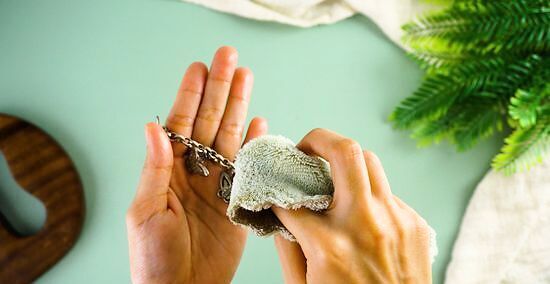
Rub the jewelry with a little polish. Moisten a soft silver-polishing cloth or the sponge included with the silver polish and take a little bit of polish onto the cloth. Rub the polish into the silver jewelry gently. Use only a straight-line, back-and-forth motion. Avoid scrubbing or rubbing in circles, since this can leave scratches or patterns in the surface of the jewelry. Just let the polish do the job.
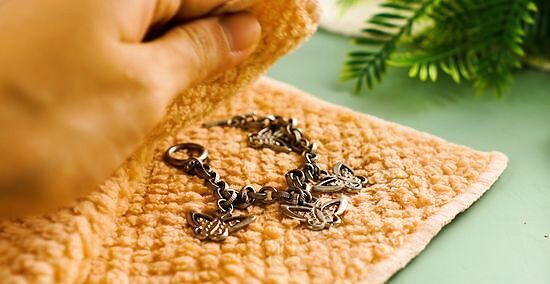
Rinse and dry the silver jewelry. Rinse it under cool running water. Be sure to clean off all of the polish residue so it won't continue working on the surface of the jewelry. Dry it completely using a soft cloth.

Consider using common household products for less rare or less valuable pieces. They will usually work to remove tough tarnish, but may cause damage such as pock marks or scratches. Try them at your own risk. Try toothpaste. Select a plain white toothpaste without the special whitening options. Take a soft, dampened cloth or a damp sponge and put some toothpaste on it. Gently rub over the silver jewelry in straight, back-and-forth motions. Be very gentle, and if you notice scratching at any point, stop and rinse the toothpaste off. As the cloth or sponge becomes dark with tarnish, add more toothpaste to a clean part of the dampened cloth/sponge and continue gently polishing. Rinse thoroughly with warm water and dry with a soft towel. Baking soda may remove stubborn tarnish, but don't use it unless you don't mind the risk of damaging the silver. Make a paste of baking soda and warm water, gently rub it into the surface of the jewelry, and rinse when the tarnish is removed.
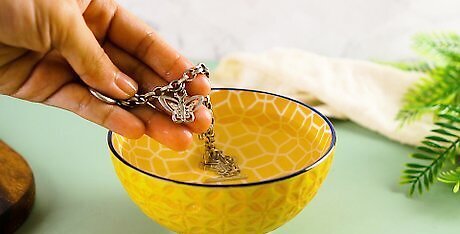
Try a silver dip. Commercial silver "dips" can dissolve stains without rubbing the silver jewelry, although they may take off a layer of silver. For this reason, they should only be used as a last resort. Contrary to what the word "dip" implies, professionals rarely actually soak silver in these products, at least not for long. Dips are generally harsh, potentially dangerous chemicals, so follow the directions carefully and consult a professional when in doubt.
Maintaining Your Jewelry
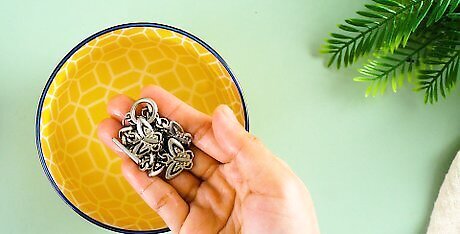
Clean it often. Clean your silver jewelry often, and clean it promptly after use. Silver jewelry that is frequently used rarely has tarnish problems. When tarnish is not yet present, or when it's just beginning to develop, simply wash your silver jewelry in warm (not hot) water with a gentle, phosphate-free detergent. Prompt cleaning is especially important when the silver jewelry has been exposed to certain foods containing sulfur, or those which are acidic or salty. In particular, common foods such as table salt, eggs, some fruits, onions, mayonnaise, and vinegar are harmful to silver. In any case, wash your silver jewelry right away or at least rinse it well with warm water, and don't leave silver sitting in dishwater that may contain traces of these foods.
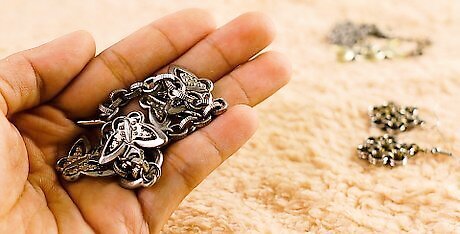
Wash it separately. It's a good idea to wash silver separately from your other silver pieces, like bowls or silverware, because metal sinks and utensils can scratch silver jewelry. You should also avoid using rubber gloves when washing silver, as rubber corrodes silver jewelry. Stainless steel can also damage the finish if it comes into contact with your silver jewelry, so avoid putting it in the sink; use a bowl to wash it in instead.
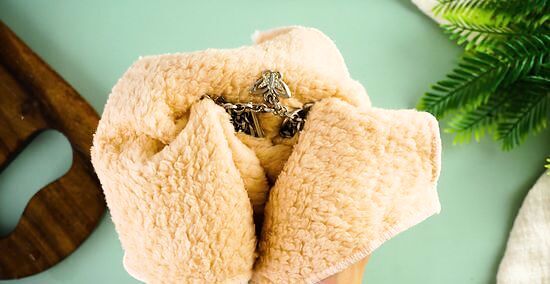
Dry it with a polishing cloth. Use a special polishing cloth or simply a soft, lint-free cloth to gently rub the silver clean after washing. Make sure it gets completely dry. Silver can be so soft that even using a scratchy, rough towel could be enough to make indentations in its surface. Make sure to use a soft cloth. As you dry the jewelry, gently buff the shine back with a soft cotton cloth.
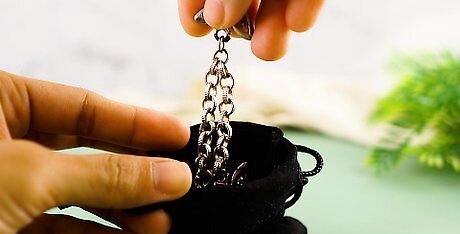
Store your silver jewelry correctly. Beyond prompt and frequent cleaning, the best way to preserve your silver is to store it correctly. Make sure each piece is completely dry before storing it. You can buy special bags for storing silver jewelry that prevent them from getting tarnished. If you don't have the bags, use this technique: Wrap each piece of silverware in acid-free tissue paper or anti-tarnish paper. You can also wrap pieces in flannel. Store the silver in a compartment separate from the rest of your jewelry. Never store silver jewelry where it can contact rubber, stainless steel, or paint.



















Comments
0 comment